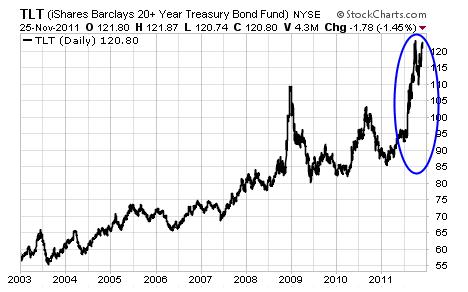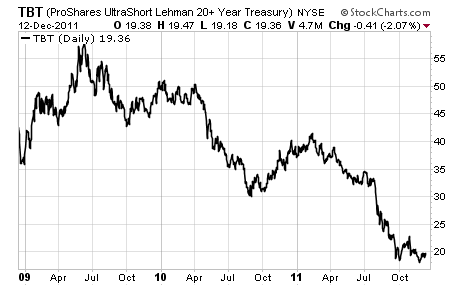First, I just wanted to thank all of you, my readers, for the overwhelming response regarding The Trade of the Decade. I knew our readers here at Wyatt Investment Research were savvy, intelligent, self-directed investors, but I had no idea how truly astute many of our readers were when it came to one of the more complicated financial issues for investors to grasp – U.S. bond prices.
Parabolic Move
As I stated several weeks ago, the 10-year chart of the iShares 20+ Year Treasury Bond Fund (NYSE: TLT) below is evidence of how interest rates and the bull market in bonds has evolved since 2003. If you look towards the blue oval you will notice what should be the final stages of the decade-long bull market in bonds. There is no doubt that the move in 2011 has been parabolic with Treasury bonds soaring over 40%.

Fortunately for the bond bulls, given all of the world's troubles, 'the safety trade' still looks intact. But, how much longer can rates stay at record lows? Realistically, the reward is now to the downside.
Trade of the Decade – Short Bonds, Long Yield
The reward IS to the downside. Parabolic moves or bubbles always move back to the mean, but many traders have lost their shirts attempting to call a bottom or a top – just ask bond guru Bill Gross.
Knowing that we are no smarter than any other investor out there, we want to choose a strategy or approach that allows us plenty of duration because it could be years before bonds revert back to the mean.
So, with the belief that both interest rates and inflation will rise, then shorting bonds should be the trade of the decade.

There are several ways to short bonds. You could short TLT, buy TLT puts, etc., but a few of my favorite ways are to buy the TBT ETF outright, or TBT LEAPS calls. LEAPS, or Long-term, Equity Anticipation Securities, are long-term options that typically have a life of two years or longer.
I like TBT because it is a more aggressive, highly liquid ultra-short for 20+ Year Treasuries that offers LEAPS that go out until Jan14 (767 days until expiration).
Because of my conviction that the bond bubble will eventually burst wide open, I want to have some exposure to an aggressive ETF.
Again, my preference as an options trader is to use an options strategy that allows for duration. In this case, I would buy LEAPS calls on TBT with the intent to roll them out further if bonds remain stagnant or rally.
The reason I would use LEAPS is because I prefer not to tie up a significant amount of capital to one position. Yet, I still want a decent amount of exposure, so a leveraged position like LEAPS allows me significant, defined exposure.
So, knowing that my risk is defined, how much would it cost to add one Jan14 LEAP contract to my overall portfolio?
Just looking at the options chain for TBT below you could be the Jan14 20 (slightly out-of-the-money) LEAPS call for $4.60, although you could work the order and most likely buy the call for approximately $4.50.

The other strikes do not have tight enough bid-ask spreads for my liking. The reason: if you look at the open interest for the Jan14 option chain you will notice that there are 740 contracts traded at the Jan14 20 call strike. The other strikes have far less volume and, as you can see, liquidity (tight bid-ask spread) suffers.
Again, this is just one of many ways to play the short bonds trade.
Shorting bonds can be a high-risk strategy, with the potential for large losses when selling bond futures, shorting bond ETFs, or buying TBT calls. Always consider where you stand on the issue, and if and how it makes sense for you to proceed.
Remember, risk-management through position-sizing is the key to long-term investment success.
If you have any options-related questions please do not hesitate to email me at optionsadvantage@wyattresearch.com.
Until next time,
Andy Crowder
Chief Options Strategist and Editor
Options Advantage
Wyatt Investment Research
Disclosure: None
 Facebook
Facebook
 Twitter
Twitter